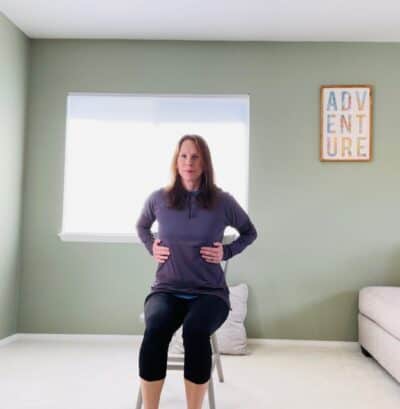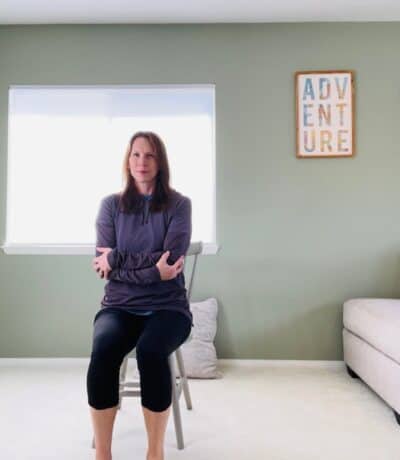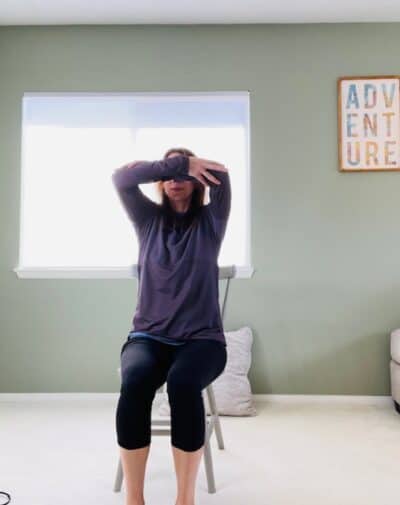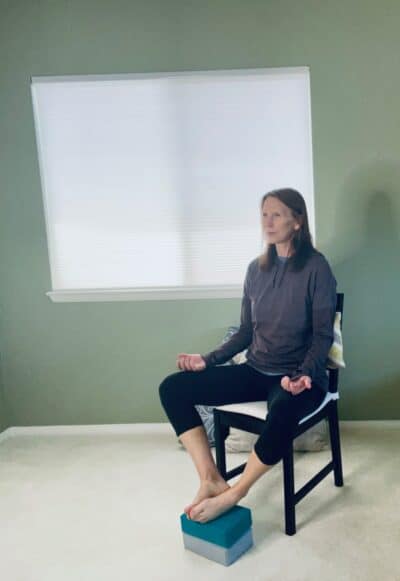What Does It Mean To Be Mindful?
You have probably heard of the term mindfulness a bit lately. But what exactly is it? Well, basically it is the act of being in the present moment and fully aware of what we are doing. Awareness of what we are seeing, doing, feeling, our environment- all this while being free from judgment or distraction. It is living in the present and not being concerned about the past or the future. Mindfulness exercises for adults and seniors -or anyone-can be practiced anywhere
This post contains affiliate links. I earn from qualifying purchases. This means that I may earn a commission should you choose to sign up for a program or make a purchase using my link. This is at no extra cost to you. I only recommend products that I truly believe are helpful. See our Privacy Policy and Disclosure pages
Mindfulness can be a part of meditation, where we would carve out a block of time to sit quietly. One of the many great things about mindfulness practices is that we can easily fit it into our daily lives. Research on this topic is growing. If you are interested, take a look at some information and research here:
Yoga, mindfulness-based stress reduction and stress-related physiological measures: A meta-analysis
It can be a way to help with the treatment of anxiety and depression. Mindfulness helps with depression by allowing you to become more grounded in the present. Depression can cause us to dwell on events of the past, as well as to worry about what is coming in the future. Mindfulness also helps one to not get trapped in one thought- we can work to train ourselves to just let a negative thought come and then let it go (National Institutes of Health, 2021). Mindfulness should not be a substitute for conventional care, but it can be a valuable complementary approach. Always see your healthcare provider if you have any concerns.
It can also simply be a way to take a break from a stressful situation, take a few deep breaths to calm the nervous system, and allow your attention to be focused on something else-the present moment. Then, you can return to the task at hand with better focus. It does not have to be overly complicated. One simple way to get started is by trying not to multitask. We often think that it is saving us time and making us more productive, but the opposite is true: The Myth of Multitasking
If you are looking for mindfulness exercises for adults and want to take part in a formalized Mindfulness program, I suggest looking for one that is research based or associated with a medical school or university. Or if you are interested in more information and ways to add a mindfulness practice to your day, you may find this book helpful: Practicing Mindfulness.
Keep reading for some simple mindfulness exercises for adults and seniors-or anyone really- that you can start implementing right now. They are all accessible right from the chair and do not require any equipment. They all serve to help you bring some awareness to the present moment. Remember to not judge any actions or thoughts- be kind to yourself. Not all of these will resonate with everyone, but take a moment and see if there is one that may work for you (or someone you care for).

Simple Mindfulness Exercises For Adults And Seniors: Getting Started
Let’s take a look at a few accessible and practical exercises that we can implement in our daily lives. We will take a look at two simple breathing exercises to help us focus on the present, one exercise to help us check in with the body and the mind, and three ways to add mindfulness to our daily routine.
2 Simple Breathing Exercises To Help Focus On The Present Moment
There are many breathing techniques out there. Always be mindful if you have any respiratory issues or medical issues related to our breathing. Some of the common yoga breathing techniques ask for holding the breath and these may not be right for everyone. Here we have two simple exercises that can help us to focus on our breathing and how the body feels. We can do this anywhere and at anytime. Take a look and see when and where you could add these to your daily routine.
- Take some deep breaths and just notice how you feel. Focus on the inhale and the exhale- how it feels, how it sounds. If the mind wanders, just come back to the breath. Try not to be distracted by external noise- think of any extraneous sounds as simply music. You may choose to close your eyes. Continue for one or two minutes- or for as long as you want. Do not stress about it. That’s it!
- Place your hands on your outer ribs on either side of your body (if it is uncomfortable to do so, you can also do this lying down or visualize the rib cage expanding out to the sides and then contracting back). Take some slow deep breaths and feel the rib cage expand out to the side as you inhale. Notice the sensation in the hands as you exhale (mobility in the rib cage is important for proper breathing). Take some easy breaths here as you simply notice the sensations- the sound of your breath, the sensation in your hands, the movement of the ribs. Continue for one to two minutes-or as long as you want.

1 Simple Way To Check In With The Body And The Mind- Try A Body Scan
We can do this seated, lying down, or standing up. Start at the bottom of the feet and simply notice how the soles of your feet feel. Next, go up to the toes and ankles and notice how they feel. Continue up to the shin and calves. Work your way up to the knees and then the thighs. Move your way up to the pelvis and hip area and check in there. Travel up through the torso, the back, and the chest.
Notice how you are breathing. Continue to the neck, the muscles in the face and jaw, and all the way to the top of the head. Now, travel back down to the shoulders, forearms, and hands. You may take any easy movement along the way- contract and relax the muscles, circle the ankles or wrists, open and close the hands, scrunch up the toes- anything that helps you to feel what is going on in each body part.
Really try to take your time and focus on how each part feels. Try to relieve tension as you travel through the body. This can help you discern where tension or muscle pain may be coming from- maybe the tension in your hands is coming from the shoulder or neck. When we compensate in our movements, pain shows up in different places.
You may have shoulder arthritis and limited range of motion in the shoulder- maybe you compensate and put more load on the smaller muscles in your wrist and hand- this may result in issues with the tendons in the hand down the road. A body scan is a good way to check in- are there adjustments you can make? Are there adaptations you can use? Give it a try, it doesn’t have to be perfect- everyone will have a different experience here. We can be creative with mindfulness exercises for adults and seniors.
You may like to follow along to this short video to give you the idea-but there are many to choose from: 3 Minute Meditation For Beginner-Feet, Hands, Forehead
2 Simple Ways We Can Add Mindfulness To Our Daily Routine
1.Bring attention to the environment
If possible, go outside and take in the nature around you. Use all of your senses as you take in the environment. Try to focus only on the present moment. How is the temperature? Do you feel a breeze? What do you hear and see? How does it smell? Try this for 1-2 minutes or 10 minutes- whatever feels right. Just try to stay in the present moment.
2.Be mindful when eating
Give mindful eating a try. Slow down and focus on the taste and sensations. Don’t multitask while you are eating. Pay attention to your posture and chew completely. Notice how you feel. Do you feel rushed? Are you tense? Are you thinking about what you have to do next? Let the thoughts come in and then let them go and return to your focus.
3 Exercises to Bring Awareness To The Body, Breath, And Mind
1.Synchronize breath with movement
Yoga can be a great way to practice moving with the breath. This allows us to have a better connection between the mind and the body. Try this simple pose- Mountain Pose with Arms Raised. Here we will practice it with the arms crossed to get a better sense of grounding-notice the sensations in your hands as they hug the elbows.


- Begin seated with a long spine and feet planted firmly and evenly on the floor
- Clasp opposite hand to opposite elbow
- On an inhale, raise the elbows up towards the sky as high as is comfortable (do not force or strain)
- On an exhale, release the elbows back down
- Repeat 3-5 times or as desired
2. Simple restorative pose to help calm the nervous system
Restorative poses can help us achieve a sense of grounding as we focus on the breath and relax. Try this seated version of the Bound Angle Pose. You can do this lying down as well- find a comfortable and supported position and just simply rest for a few minutes. You may also be interested in checking out this post on Restorative Yoga or this 20 Minute Restorative Chair Yoga Sequence.

- Sit supported in your chair with a small pillow or rolled towel behind the low back
- Place the outer edges of the feet on yoga blocks or books
- Let the hips open as the knees fall to the sides
- Breathe evenly for 3-5 minutes or more as desired
- Focus on the support of the chair as you breath and release any tension in the hips
3.Foot exercise to promote grounding
Bring your attention and focus to the sensations in the feet as they support you, either seated or standing. Try this simple exercise, or you can learn more here: Chair Yoga and The Feet.
- Simply bring awareness to the soles of your feet. Become aware of how it feels.
- Bring awareness to the distribution of weight
- Notice the toes- lift them up and then place them back down
- Lift the heels up and down- notice if the feet move the same or differently
- Breath evenly as you explore the sensations, movements, and muscles in the feet- take your time here.
- Alternatively- if you have impaired sensation in the feet, you can try this with the hands. Place the hands on the thighs, a table, or clasp the hands together as you notice all the muscles in the hands and fingers. Stretch the fingers, open and close the hands, massage the muscles in the palm, and notice how it feels.
Give these simple ideas a try and see if it makes a difference in how you feel. Do you feel more calm and less stressed? Do you feel better making decisions or plans? Do you have more awareness for your breath or how you move? It won’t happen overnight, but with continued practice it can make a difference. Things don’t have to be overly complicated or laborious to have an effect. Pick one or two of these mindfulness exercises for adults and seniors that may resonate with you and give it a try.
Want More Mindfulness Exercises For Adults And Seniors (or anyone really)?
Print out this Daily Check In to help you get started.
Or you may be interested in my simple Daily Journal Notebook
You can find more health and wellness related printables in The Peaceful Chair Etsy Shop
If you would like more information on chair yoga, take a look at Is Chair Yoga Right For You?
You may be interested in learning about the 7 Types Of Rest that we need.
I invite you to read Tips for Healing With Chair Yoga for more information on how you can use chair yoga to decrease stress.
You may also like to try the 21 Day Mindfulness Challenge.
Finally, take a look at Breathing For Better Mobility for some ways to improve the breath- including 12 Energy Conservation Tips.
I invite you to sign up for the Monthly Email Newsletter to stay up to date on the latest blog posts and videos.
Namaste!
Resources
National Institute of Health. (2021). Mindfulness for Your Health. (2021). NIH.gov. Retrieved November 2, 2022 from newsinhealth.nih.gov/2021/06/mindfulness-your-health
Disclaimer: The Peaceful Chair and thepeacefulchair.com strongly recommends that you consult with your physician before starting this or any exercise program.The information provided on this website is for informational purposes only and is not to be used in place of medical advice or information from your healthcare provider. Neither The Peaceful Chair, the peacefulchair.com, nor any of its contributors shall be held liable for any improper or incorrect use of the information described and/or contained herein and assumes no responsibility for anyone’s use of the information contained in any links, videos, or any content on this website.

Leave A Comment